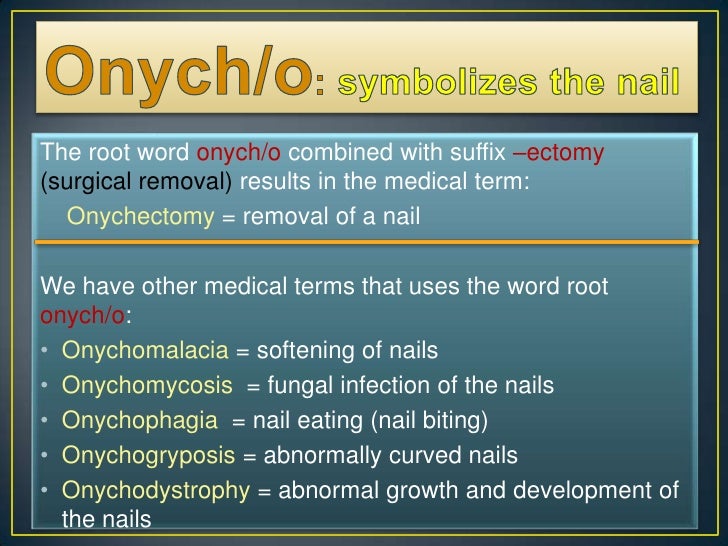
A hardened or horny cutaneous plate overlying the dorsal surface of the distal end of a finger or toe. Fungus or yeast cause changes in the color texture and shape of the nails.

Subungual lesions may be missed and the diagnosis delayed due to similar presentations to other benign nail disorders.
Medical term for nail. A rod of metal bone or other material used for fixation of the ends of fractured bones. A hardened or horny cutaneous plate overlying the dorsal surface of the distal end of a finger or toe. The nails are part of the outer layer of the skin and are composed of hard tissue formed of keratin.
One of the thin horny translucent plates covering the dorsal surface of the distal end of each terminal phalanx of fingers and toes. A nail consists of a visible corpus or body and a radix or root at the proximal end concealed under a fold of skin. Nail terminology codes and conceptsopen.
Hair nail and sweat Nail dystrophy. Nail plate Discolouration of the nail Abnormalities of the cuticle Abnormalities of the nail fold Nail shape Loss of nails Lesions around the nail. A toenail is produced by living skin cells in the toe.
Paronychia is the medical term for an infection in the skin around the nail which becomes inflamed swollen and painful. People can treat mild paronychia at home and a doctor can provide. Onychauxis is a nail disorder that causes fingernails or toenails to grow abnormally thick.
Over time the nails may become curled and turn white or yellow. This thickening of the nail may force. Torn or Detached Nail Facts.
Picture of a torn detached toenail. Fingernails and toenails like hair are composed of protein and fat and are not live tissue. Nails grow a bit more than one-tenth of an inch per month and require three to six months to completely.
Skin-coloured or hyperpigmented lesions appearing as keratotic or hyperkeratotic or warty papules and plaques found on the proximal and lateral nail folds and hyponychium. Subungual lesions may be missed and the diagnosis delayed due to similar presentations to other benign nail disorders. Long-term exposure to moisture or nail polish can cause nails to peel and become brittle.
Fungus or yeast cause changes in the color texture and shape of the nails. Bacterial infection may cause a change in nail color or painful areas of infection under the nail or in the surrounding skin. Severe infections may cause nail loss.
Psoriasis may result in haphazard nail pitting onycholysis subungual hyperkeratosis ridging andor yellow hypertrophied nail plate. Eczema is associated with irregular pitting ridging and paronychia. Lichen planus thins the nail plate which may become grooved and ridged.
The nail may darken thicken or lift off the nail bed. Onychomycosis is a medical term for a typical nail disorder widely referred to as toe nail fungi. This disorder is caused as a result of various fungis kinds as well as leads to considerable nail damages.
The fungi creates in dark and damp surroundings so people using limited as well.